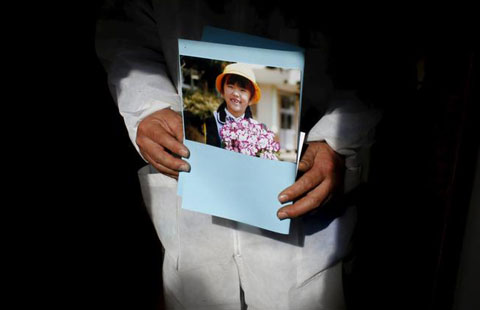The sensitive secrets of a master blender
Updated: 2016-03-12 03:07
By Yan Dongjie and Yang Jun(China Daily USA)
|
||||||||
China’s most loved liquor makes its way to customers only after rigorous testing, Yan Dongjie and Yang Jun report.
 |
|
Moutai was first produced during the Qing Dynasty (1644-1911). Traditional production methods employed at the company have remained relatively unchanged. PHOTOS BY YAN DONGJIE / CHINA DAILY |
Zhong Lin stopped wearing cosmetics and perfume in her 20s. She also swore off spicy food, which was tough for someone who grew up in Guizhou, a southern province where the chili is king.
Yet denying herself these everyday pleasures for two decades has helped make her one of the top baijiu blending masters in China.
The job requires a heightened sense of taste and smell. “If you gave me two cups of baijiu with slightly varying alcohol levels, it’d be easy for me to tell which is higher, or any other tiny differences,” she said with a confident smile.
Zhong has worked for Kweichow Moutai Co, the most famous brand of the Chinese liquor, since 1995, rising from a graduate recruit to a Class 1 taster.
She is one of 10 blending masters who are responsible for the quality and consistency of the 100 metric tons of baijiu produced daily at Moutai’s distilleries, which employ more than 20,000 people in the small Guizhou town from which the company takes its name.
“For the past 20 years, I’ve tasted the best baijiu in the world almost every day. It’s been amazing,” she said, adding that she believes it has done wonders for her liver and stomach, and that her skin is better than most women her age.
“Moutai is great for your health,” she said, repeating a statement often heard from workers at the company, although the public perception is perhaps a little different.
The company’s baijiu is made from sorghum, wheat and water from the Red River, which runs through Moutai town, “with no chemicals or artificial yeasts”, Zhong says.
The wheat and sorghum is first mixed to ferment for a year before being categorized by taste and stored in large, earthenware containers for three to four years. After that, each batch is further tested to determine the right blend to produce the trademark Moutai flavor.
“The most difficult — albeit basic — part of my job is to make sure the baijiu produced in different seasons and different years all tastes roughly the same,” she said.
Zhong is now at the peak age for tasters, 40 to 45, when the senses of smell and taste are believed to be at their keenest. However, acquiring the skills to be a blending master was not easy; it took years of practice.
At first, Zhong said she did not take her apprenticeship seriously enough and found it hard keeping up with the tiring training schedule, which often stretched into the late evening.
When her first chance to take the baijiu taster examination rolled around in 2000, she failed. “I was young and foolish, and I do regret it (not putting in the effort) because it delayed my career,” she said, explaining that the test is held only every five years.
The failure inspired her to dedicate herself to improving her skills, which involved smelling and tasting glass upon glass of baijiu, each one slightly different from the one before.
“You have to stop every now and then, take a walk to refresh the nose and drink some water to cleanse the palate.”
Her hard work paid off. She rose through the ranks and eventually gained a Class 1 certificate, the highest achievement for a blending master, last year. For that test she was blindfolded and asked to tell the difference between various cups of water, including tap, mineral and purified.
“I smelled, but smelled nothing; I tasted, but didn’t taste baijiu,” she said, recalling her surprise at the exam. “But I passed, and at least I got to know that I’m capable of distinguishing between different types of water.”
Asked to demonstrate her day-to-day work, Zhong put on a clean, white laboratory coat, washed her hands, and took out a collection of bottles and measuring glasses.
“Look at the color first,” she said, explaining the process, which takes up to one hour per sample. “Smell it from a short distance, and then take a sip to spread the baijiu on your tongue.”

 Beijing sees blue sky during the two sessions
Beijing sees blue sky during the two sessions
 Fukushima five years on: Searching for loved ones
Fukushima five years on: Searching for loved ones
 Robots ready to offer a helping hand
Robots ready to offer a helping hand
 China to bulid another polar ship after Xuelong
China to bulid another polar ship after Xuelong
 Top 10 economies where women hold senior roles
Top 10 economies where women hold senior roles
 Cavers make rare finds in Guangxi expedition
Cavers make rare finds in Guangxi expedition
 'Design Shanghai 2016' features world's top designs
'Design Shanghai 2016' features world's top designs
 Cutting hair for Longtaitou Festival
Cutting hair for Longtaitou Festival
Most Viewed
Editor's Picks

|

|

|

|

|

|
Today's Top News
What ends Jeb Bush's White House hopes
Investigation for Nicolas's campaign
Will US-ASEAN meeting be good for region?
Accentuate the positive in Sino-US relations
Dangerous games on peninsula will have no winner
National Art Museum showing 400 puppets in new exhibition
Finest Chinese porcelains expected to fetch over $28 million
Monkey portraits by Chinese ink painting masters
US Weekly

|

|







